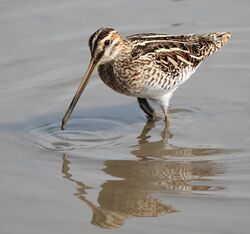Biology:Gallinago
| Gallinago | |
|---|---|

| |
| Common snipe | |
| Scientific classification | |
| Domain: | Eukaryota |
| Kingdom: | Animalia |
| Phylum: | Chordata |
| Class: | Aves |
| Order: | Charadriiformes |
| Family: | Scolopacidae |
| Genus: | Gallinago Brisson, 1760 |
| Type species | |
| Scolopax gallinago[1] Linnaeus, 1758
| |
| Species | |
|
See text | |
| Synonyms | |
|
Capella | |
Gallinago is a genus of birds in the wader family Scolopacidae, containing 18 species.
Taxonomy
The name Gallinago was introduced by the French zoologist Mathurin Jacques Brisson in 1760 as a subdivision of the genus Scolopax.[2] Brisson did not use Carl Linnaeus's binomial system of nomenclature and although many of Brisson's genera had been adopted by ornithologists, his subdivision of genera were generally ignored.[3] Instead, the erection of the genus Gallinago for the snipes was credited to the German zoologist Carl Ludwig Koch in a book published in 1816.[4] But in 1920 it was discovered that the German naturalist Johann Samuel Traugott Frenzel had erected the genus Capella for the snipes in 1801. As his publication predated Koch's use of Gallinago it took precedence.[5][6] The American Ornithologists' Union switched to Capella in 1921[7] and in 1934 the American ornithologist James L. Peters used Capella for the woodcocks in his influential Check-list of Birds of the World.[8] This all changed in 1956 when the International Commission on Zoological Nomenclature ruled that Gallinago Brisson 1760 should have priority for the genus with the common snipe as the type species.[9] The scientific name gallinago is Neo-Latin for a woodcock or snipe from Latin gallina, "hen" and the suffix -ago, "resembling".[10]
The genus contains 18 species:[11]
- Solitary snipe, Gallinago solitaria
- Latham's snipe, Gallinago hardwickii
- Wood snipe, Gallinago nemoricola
- Pin-tailed snipe, Gallinago stenura
- Swinhoe's snipe, Gallinago megala
- African snipe, Gallinago nigripennis
- Madagascar snipe, Gallinago macrodactyla
- Magellanic snipe, Gallinago magellanica
- Great snipe, Gallinago media
- Common snipe, Gallinago gallinago
- Wilson's snipe, Gallinago delicata
- Pantanal snipe, Gallinago paraguaiae
- Puna snipe, Gallinago andina
- Noble snipe, Gallinago nobilis
- Giant snipe, Gallinago undulata
- Fuegian snipe, Gallinago stricklandii
- Jameson's snipe, Gallinago jamesoni
- Imperial snipe, Gallinago imperialis
This genus contains the majority of the world's snipe species, the other two extant genera being Coenocorypha, with three species, and Lymnocryptes, the jack snipe. Morphologically, they are all similar, with a very long slender bill and cryptic plumage. Most have distinctive displays, usually given at dawn or dusk. They search for invertebrates in the mud with a "sewing-machine" action of their long bills.
Fossil bones of some undescribed Gallinago species most similar to the great snipe have been recovered in Late Miocene or Early Pliocene deposits (c. 5 mya) of Lee Creek Mine, USA. The large West Indian species Gallinago kakuki went extinct during the late Quaternary period, and despite its distribution may actually be more closely related to Old World snipe species than New World ones.
References
- ↑ "Alcidae". The Trust for Avian Systematics. https://www.aviansystematics.org/4th-edition-checklist?viewfamilies=63.
- ↑ Brisson, Mathurin Jacques (1760) (in fr, la). Ornithologie, ou, Méthode contenant la division des oiseaux en ordres, sections, genres, especes & leurs variétés. 5. Paris: Jean-Baptiste Bauche. pp. 298, 304. https://biodiversitylibrary.org/page/36294640.
- ↑ Allen, J.A. (1910). "Collation of Brisson's genera of birds with those of Linnaeus". Bulletin of the American Museum of Natural History 28: 317–335. https://digitallibrary.amnh.org/handle/2246/678.
- ↑ Koch, C.L. (1816) (in de). System der baierischen Zoologie. 1. Nürnberg: Stein. p. xxvii, 312.
- ↑ Mathews, G.M.; Iredale, T. (1920). "Sherborn and the systematist". Austral Avian Record 4 (4&5): 130–132. https://biodiversitylibrary.org/page/33271065.
- ↑ Frenzel, G.S.T. (1801) (in de), Beschreibung der Vögel und ihrer Eyer in der Gegend von Wittenberg zur Naturgeschichte des Churkreises, Wittenberg aus der Tzschiedrichschen Officin, p. 58, OCLC 993253150
- ↑ Mathews, G.M.; Iredale, T. (1920). "Sherborn and the systematist". Austral Avian Record 4 (4&5): 130–132. https://biodiversitylibrary.org/page/33271065.
- ↑ Peters, James Lee, ed (1934). Check-list of Birds of the World. 2. Cambridge, Massachusetts: Harvard University Press. p. 274. https://biodiversitylibrary.org/page/14483087.
- ↑ Hemming, Francis, ed (1956). "Direction 39: Substitution of Gallinago Brisson, 1760, for Gallinago Koch, 1816 (class Aves) on the Official List of Generic Names in Zoology (correction of an error in the ruling given in Opinion 67)". Opinions and Declarations Rendered by the International Commission on Zoological Nomenclature. 1 Section D Part D.4. London: International Trust for Zoological Nomenclature. pp. 95–138. https://biodiversitylibrary.org/page/34613318.
- ↑ Jobling, James A (2010). The Helm Dictionary of Scientific Bird Names. London: Christopher Helm. p. 170. ISBN 978-1-4081-2501-4. https://archive.org/details/helmdictionarysc00jobl_997.
- ↑ Gill, Frank; Donsker, David; Rasmussen, Pamela, eds (July 2021). "Sandpipers, snipes, coursers". IOC World Bird List Version 11.2. International Ornithologists' Union. https://www.worldbirdnames.org/bow/sandpipers/.
Wikidata ☰ Q786045 entry
 |

